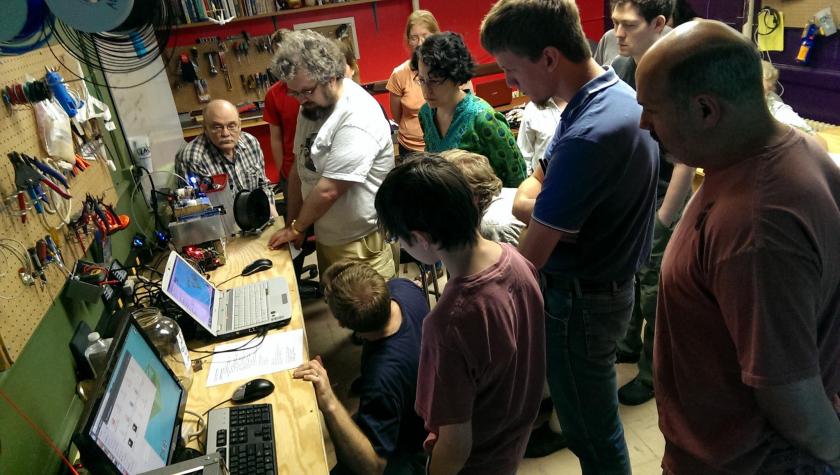
Assistant Professor Emily Knox (MS ’03) knows her way around a reference desk. She is a scholar working in intellectual freedom and censorship. She holds multiple degrees from prestigious universities. And now, thanks to Makerspace Urbana, she has added even more talents to her toolbox. She can work a soldering iron. And sew a flapper dress.
When Knox moved to Champaign to begin teaching at GSLIS, she joined Makerspace Urbana as a way to meet new people in the community. She quickly became a core member of the group, even working to help organize last fall’s Urbana-Champaign Mini Maker Faire.
“Being a part of Makerspace Urbana has increased my confidence in making and fixing all sorts of things. I've learned how to solder and greatly improved my sewing skills. For example, I recently broke the screen on my smartphone and rather than pay for it to be fixed, I bought all the supplies and I repaired it at Makerspace,” Knox said.
 Makerspaces are popping up all over the country, and their purpose is to bring production into the hands of everyone—literally. By providing access to tools and technology in a welcoming group environment, makerspaces allow for tinkering, collaboration, exploration, making, and ultimately, confidence building.
Makerspaces are popping up all over the country, and their purpose is to bring production into the hands of everyone—literally. By providing access to tools and technology in a welcoming group environment, makerspaces allow for tinkering, collaboration, exploration, making, and ultimately, confidence building.
Many public libraries are making space for makerspaces either by providing space and equipment, or in conducting shared programming with independent area groups.
“Makerspaces are the next step in making resources available to the community. If a library has funding, it can provide access to all sorts of resources—not just books,” said Knox. “And you can choose to include in your makerspace anything your patrons might use, from tech to power tools.”
For the 2013 Teen Tech Week, librarian Joel Spencer (MS ’10), partnered with Makerspace Urbana and the Champaign-Urbana Community Fab Lab to create a series of workshops and open lab times at the Urbana Free Library. Teens were invited to learn how to solder by making a “blinky robot badge,” build a simple synthesizer, and make a didgeridoo, as well as use musical instruments, a 3D printer, and media production software.
Spencer was so pleased with the success of these events, that he now holds an open lab three times a week. This teen-only space attracts twenty to thirty teens each day it is open, and they are working on projects such as writing and recording music and designing game pieces that are printed on the 3D printer. Many GSLIS students volunteer during these open labs to help the teens.
“The atmosphere I’m trying to create is open—that is why I called it an open lab,” said Spencer. “There tends to be a built-in fear about technology, and that can build up a barrier. I wanted to make the space available to everybody, so it was more of a hangout, but at the same time great stuff is also going on in the same room. Our makerspace blends naturally into what is already occurring, and I try to make it very approachable. Then the teens can ask, ‘How did you do that?’” said Spencer.
In setting up his space, Spencer worked closely with fellow librarian Amber Castens (MS ’11) and GSLIS doctoral candidate Jeff Ginger, who works with the operations and community engagement aspects of the local Fab Lab. While the Fab Lab is physically located on the Illinois campus, Ginger and his colleagues have created partnerships with a number of institutions to bring the Fab Lab off campus and into the community.
 “Historically, fabrication and production facilities have been open only to highly privileged individuals—professional designers, engineers, and people in university and corporate settings,” he said. “That’s a problem in two ways: one, it keeps the access to just the highly privileged individuals; and two, it continues the privatization of information production and information processing.”
“Historically, fabrication and production facilities have been open only to highly privileged individuals—professional designers, engineers, and people in university and corporate settings,” he said. “That’s a problem in two ways: one, it keeps the access to just the highly privileged individuals; and two, it continues the privatization of information production and information processing.”
Erin Fisher (MS ’08) is the library program manager at Grand Valley State University in Allendale, Michigan. She is working with colleague Kyle Felker to develop a makerspace for students. “At the heart of academic libraries lies a commitment to growth, learning, and exploration,” she said. “By bringing makerspaces into libraries, we can provide more options for self-directed, innovative learning; we can provide a space that acts as an incubator for ideas; and we can provide tools for the rapid prototyping of those ideas.”
Spencer has seen the difference programming like this can make for teens. “The effect of the programming has been phenomenal, especially in kids who normally had behavioral issues in the library,” he said. “Now we are working on something together. Now we are learning together. It really has had wonderful ripple effects. You get to know each other on a different level.”